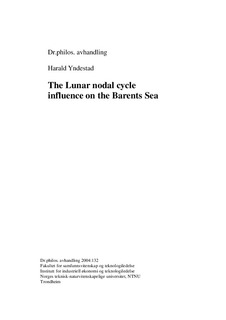| dc.contributor.author | Yndestad, Harald | nb_NO |
| dc.date.accessioned | 2014-12-19T14:24:44Z | |
| dc.date.available | 2014-12-19T14:24:44Z | |
| dc.date.created | 2004-11-26 | nb_NO |
| dc.date.issued | 2004 | nb_NO |
| dc.identifier | 125102 | nb_NO |
| dc.identifier.isbn | 82-471-6488-4 | nb_NO |
| dc.identifier.uri | http://hdl.handle.net/11250/264975 | |
| dc.description.abstract | The Barents Sea contains one of the most productive marine areas in the world. For centuries, Northeast Arctic cod and Norwegian spring spawning herring have been of vital importance for the Norwegian fish export industry and hence economic growth in Norway. It has been common knowledge that the biomass of different Barents Sea species experiences both shortand long-term fluctuations. These fluctuations have been explained by changes in herring cycles and cod cycles, or by the introduction of new fishing equipment, and more. Norwegian marine research began in earnest at the beginning of the 19th century. The main task for researchers was to discover how nature influenced cod stocks and the effects these fluctuations had on the lives of people who depended on fishing for a living. Nearly 100 years later, scientists still disagree over the causes for the biomass fluctuations in the Barents Sea. At the same time, marine research has produced long time series, which can now be analyzed using new methods. This thesis represents an investigation of a number of long time series of Arctic climate indicators and biomasses in the Barents Sea. The purpose of this analysis has been to identify a potential stationary cycle in the biomasses. A stationary cycle in the biomass allows for expanded possibilities for better long-term biomass forecasting.
The methods are based on general systems theory, analysis of systems dynamics and a wavelet analysis of time series. The wavelet analysis has identified the cycle time and the cycle phase of the dominant cycles in the time series. The phase-relation between the identified cycles contains information abort the dynamic chain of events between climate indicators and the biomasses in the Barents Sea.
The investigation has identified harmonic and sub-harmonic cycles of the 18.6-year lunar nodal cycle in all analyzed time series. The identified lunar nodal spectrum is explained by a gravity force from the 18.6-year lunar nodal cycle as the First Cause. The energy from the 18.6-year gravity force from the moon introduces a chain of oscillating events. The oscillating gravity introduces a lunar nodal spectrum in the lunar nodal tide and the polar position. A wavelet analysis of time series indicates that movement of the polar position introduces a new lunar nodal spectrum of circulating water in the Arctic Ocean. This circulation water interacts with the 18.6-year lunar nodal tide in the Atlantic Ocean and introduces an oscillation in the extent of Arctic ice, and an oscillation in the inflow of the Atlantic Ocean to the Barents Sea. The lunar nodal spectrum of Atlantic inflow introduces a lunar nodal spectrum in the Barents Sea ecology system. Analysis of the biomass in the Barents Sea shows that long-term growth, reduction and collapse are associated with the phase-relation between the biomass eigen dynamics and the lunar nodal spectrum of Atlantic inflow. | nb_NO |
| dc.language | eng | nb_NO |
| dc.publisher | Fakultet for samfunnsvitenskap og teknologiledelse | nb_NO |
| dc.relation.ispartofseries | Doktoravhandlinger ved NTNU, 1503-8181; 2004:132 | nb_NO |
| dc.subject | | en_GB |
| dc.subject | Biologi | en_GB |
| dc.subject | NATURAL SCIENCES: Biology | en_GB |
| dc.title | The Lunar Nodal Cycle Influence on the Barents Sea | nb_NO |
| dc.type | Doctoral thesis | nb_NO |
| dc.source.pagenumber | 180 | nb_NO |
| dc.contributor.department | Norges teknisk-naturvitenskapelige universitet, Fakultet for samfunnsvitenskap og teknologiledelse | nb_NO |
| dc.description.degree | Dr.philos. | nb_NO |
| dc.description.degree | Dr.philos. | en_GB |
